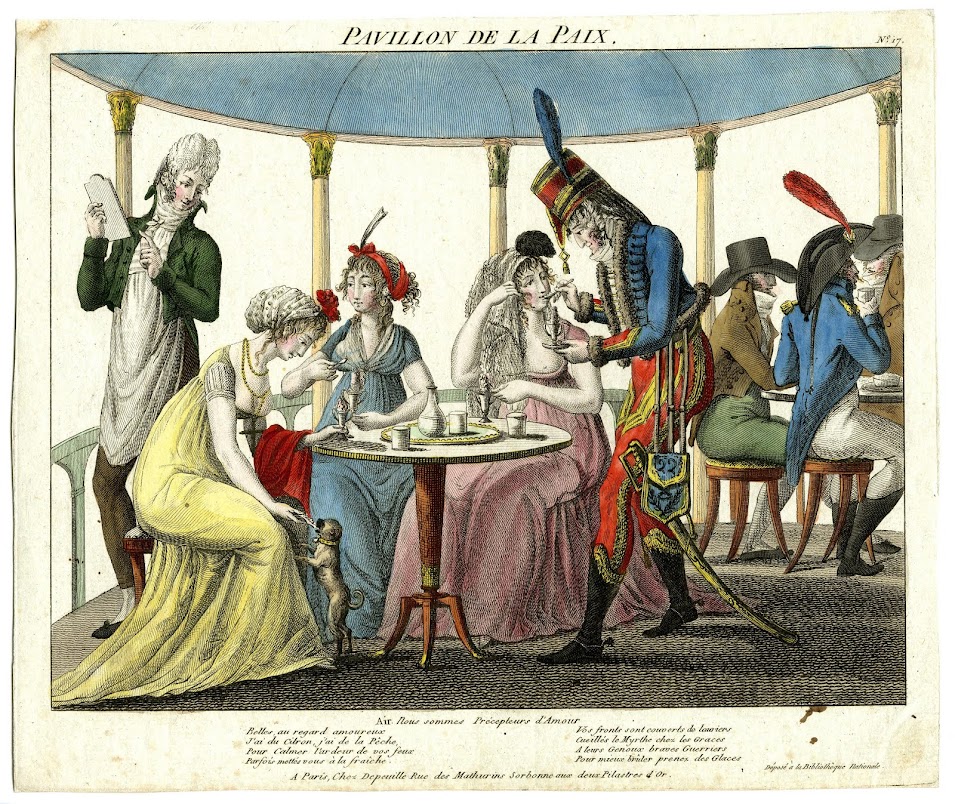February 15, 1811
 |
| Picture by C. Barreto - Barreto-Lancaster Collection // www.napoleon-fashion.com |
Gravure 1123
Coeffure en Cheveux, ornées de Bandelettes en Argent. Robe de Tulle
Updo with own hair, decorated with silver bands. Tulle-gown.
 |
| Picture by C. Barreto - Barreto-Lancaster Collection // www.napoleon-fashion.com |
Gravure 1122
Coeffure Egyptienne, ornée de fleurs et de fruits Argent, Velours et Or
Egyptian Updo, decorated with flowers and fruit in Silver, Velvet and Gold
Due to space limitation the explanation to No 1122 is moved to the next issues.
**************
FASHION
By today Milliners use flowers made from velbet, as do the hairdressers, especially red velvet; The rosa-canina strings so often seen on white capote are made in this way, the big bow is not the Must anymore. We can also ascertain that feathers are less often sported. Someone asked about the blue pearls (mentioned earlier this year), these are made from lapis (lapislazuli, that is). Lapis, being expensive already quickly becomes rare . Men used six or seven plates in one watch-chain; Turquoise, mosaïc and antique heads (I interpret this as cameos) are fashionable for the same use.
******************
PARIS, ce 14 Février 1811
Paris awaits impatiently the arrival of several important people. Sophocles needs to show himself at the Opéra, Mohammed II will appear at the Français (we can assume "the Comédie Français", Sleeping Beauty might encounter the same succes at Vaudeville as Fanchon did before her; A Poet and a Musician will make the good days for the Opéra Variétés, Griseldis will give a concert at the Odéon, and the Baron of Felsheim is going to launch this carnival at the l'Ambigu-Comique, to the great pleasure of the enlightened fans of the Boulevard.
************
Clashing colours, as red, scarlet, poppy-red, amaranth (sort of pinkish-red) what were all the rage last winter, the nec plus ultra in good taste in ladies dress are now completely banned, and are not used anymore unless to decorate a hat or a white dress. Soft shades, Rosy pink, white, Serin (Yellow), and blue took over today's palette of choice: A white hat, crowned with six blue plumes, a dress idem embroidered with cornflowers (or in cornflower-colour), decorated with soft blue ribbons, idem for the shoes; That's the look of today: One is tempted to explain, that our ladies are the living image of candour and fidelity, but a moralist poet said already a long time ago: Nimium ne crede colori.
Most of our subscribers will ask us now: "Why Latin, what does this line say?" We would reply that whenever sadly we have to say something what might hurt the beautiful gender, we will express this statement in a language no-one understands.
(This last phrase might be a little notch back to an earlier edition, where a writer propagated very strongly that ladies ought to learn Latin - sadly only the first part of the text is preserved at the BNF, that's why I didn't include it in an earlier post. Many of Centyeux notes have a nasty twist at the end, what might or might not turn the whole composition into reverse gear. Therefore I couldn't fathom whether he approves or disapproves of ladies studying the antique world.)
************
One doesn't give big gala-dress balls anymore, but nevermind, even masqued balls big gala is the must. The domino worn by a young man is nothing else than some sort of silk redingote where he takes great care to close it but carelessly, or if needed loosens the fastening cords to show off the elegance of his habit.
For ladies, the domino is the most boring disguise, black taffeta is forbidden, required is white satin, or hortensia Levantine (Hortensia = a bright pink, Levantine, the heavy twill fabric, mostly silk, but can also be silk/wool), in the way of a hooded coat, the simple domino taking on the air of the most elegant dress, with lace decorations (falbalas) like a dress, but contrary to the most beautiful dresses can only be worn once. Character disguises offer a wider resource for creativity, more varied and more flattering for a beautiful woman; and they are also the ones chosen more often. Cydalise wears the costume of the Queen of Persépolis, Florine appears in the attire of a Swiss shepherdess, yet silk replaces coarse wool*, wooden clogs are replaced with leather escarpins, the cross à la Jeanette is made from fine pearls, and the flowers ornamenting her head from diamonds.
This lady is dressing as a goddess, this one as a fay, Such are the most fashionable balls, offering the double advantage of being interesting like masqued balls, but are glittering occasions like glamourous gala. These occasions are magical, where men are enchanted, but ladies are the enchantresses.
(*bure = a coarse reddish wool. I'd like to know where this fits with Swiss peasants, as artists portraying them as Koenig, Lory père & fils and Toepffer mention the fabrics, and don't mention bure as the main fabric ;-) )
LE CENTYEUX
**************
Everyone wants to be the talk of town or talk about himself
[…] I appear to applaud when actually I disapprove deeply. I cry "Merveille" - (Wonderful, miracle) in the sight of bizarre fashion - no doubt caused by simply being baffled.
LE RÔDEUR
The full page is much much longer, and I plan to translate it in detail in a separate article. Last Sunday I have had an interesting conversation with a dear friend, who read, that both, Le Rôdeur and Le Centyeux are in fact the same writer, both of them being the editor, De La Mésangère. I love this idea, and I hope I'll find more about his activities.
***************



